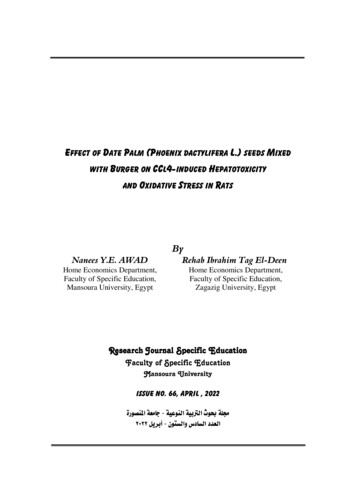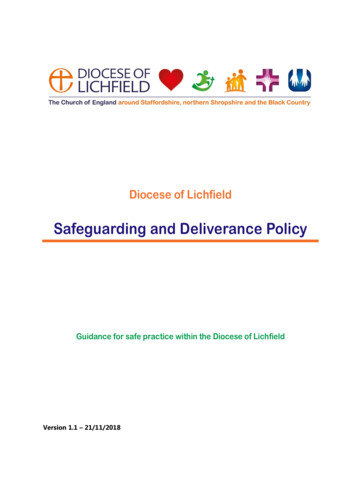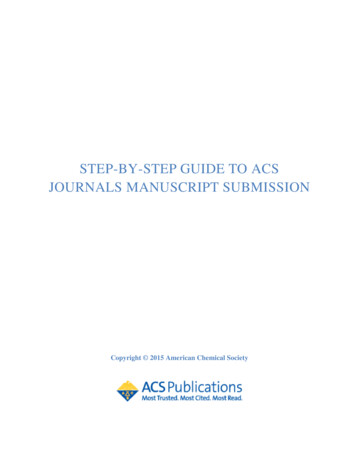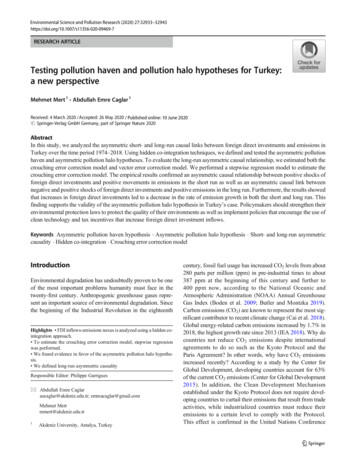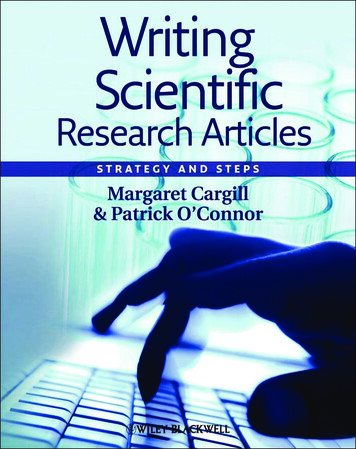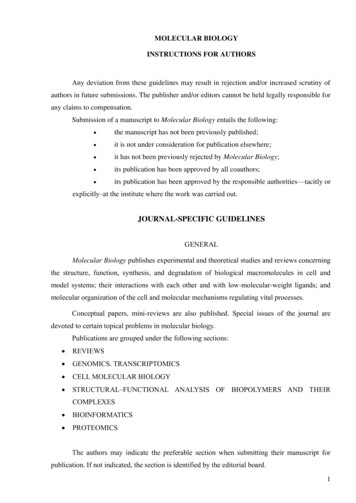
Transcription
MOLECULAR BIOLOGYINSTRUCTIONS FOR AUTHORSAny deviation from these guidelines may result in rejection and/or increased scrutiny ofauthors in future submissions. The publisher and/or editors cannot be held legally responsible forany claims to compensation.Submission of a manuscript to Molecular Biology entails the following: the manuscript has not been previously published; it is not under consideration for publication elsewhere; it has not been previously rejected by Molecular Biology; its publication has been approved by all coauthors; its publication has been approved by the responsible authorities—tacitly orexplicitly‒at the institute where the work was carried out.JOURNAL-SPECIFIC GUIDELINESGENERALMolecular Biology publishes experimental and theoretical studies and reviews concerningthe structure, function, synthesis, and degradation of biological macromolecules in cell andmodel systems; their interactions with each other and with low-molecular-weight ligands; andmolecular organization of the cell and molecular mechanisms regulating vital processes.Conceptual papers, mini-reviews are also published. Special issues of the journal aredevoted to certain topical problems in molecular biology.Publications are grouped under the following sections: REVIEWS GENOMICS. TRANSCRIPTOMICS CELL MOLECULAR BIOLOGY STRUCTURAL–FUNCTIONAL ANALYSIS OF BIOPOLYMERS AND THEIRCOMPLEXES BIOINFORMATICS PROTEOMICSThe authors may indicate the preferable section when submitting their manuscript forpublication. If not indicated, the section is identified by the editorial board.1
Submission of a manuscript for publication in Molecular Biology implies that the authorshave not submitted analogous material to other journals, that this material has not been publishedpreviously, and will not be submitted or accepted for publication in any other journal.If the editorial board becomes aware that analogous material has been submitted toanother journal (possibly under a different title or with the authors listed in a different order), themanuscript will be immediately returned to the authors and the editorial office of the otherjournal will be notified and advised to reject the manuscript due to infringement of the copyrighttransfer agreement (see below).The authors of manuscripts should conclude a copyright transfer agreement with PleiadesPublishing, Inc., the publisher of the English-language version of the journal. The agreementmust be correctly completed, signed by all authors, and submitted in PDF together with themanuscript. Otherwise, the paper will not be accepted. The forms of the copyright transferagreement are available from the editorial board or can be downloaded from the websites of thejournal and publisher:Editorial board: http://www.molecbio.ru (e-mail: jrmolbio@gmail.com )Publisher: https://www.pleiades.onlineMolecular Biology publishes reviews written at the editors’ request. Authors willing tocontribute a review article should submit an application containing an abstract of the prospectivereview and the list of author’s publications over the past five years, which will be considered bythe editorial bmittedviahttps://publish.sciencejournals.ru. In exceptional cases, it is possible send it by e-mail mail tojrmolbio@gmail.com. Note that the authors can interact with the editorial board via the internetafter registration and password generation (instructions are available on the page For Authors). Apassword allows the authors to monitor processing of the manuscript.A separate file (or electronic version of the manuscript) should contain necessaryinformation about the authors (full name, address, ZIP code, phone and fax numbers, and e-mailaddress), with the corresponding author indicated separately.No payment is collected from the authors for publication. The exception is complexcolor figures published at the expense of the authors in the paper version of the journal. In theelectronic version, the publication of color figures is free.The journal does not have an accelerated option with payment for reducing the processingtime, revision, or acceptance of a manuscript for publication; however, the authors can to publish2
/ .All technological processes for preparing a manuscript for printing begin 4 months beforethe publication of the journal.FORMATThe manuscript (electronic version) should be formatted as follows.The text is printed with 1.5 line spacing and the should take approximately 29–34 linesper page: font Times New Roman, point size 12, the left margin should be 30 mm, and the topand bottom margins 20 mm.UDC (Universal Decimal Classification code) (italic, point size 9).Title of paper (boldface). The title should not be too long, too short, or insufficientlyinformative; it should reflect the main findings rather than the field and subject of study. Thewords study, comparison, analysis, etc., should be avoided.The list of authors (by initials and surname, boldface). The corresponding author shouldbe indicated with an asterisk and his/her e-mail address should be provided.The list of affiliations and addresses (italic, boldface), e.g., Institute of Cytology,Russian Academy of Sciences, St. Petersburg, 194064 Russia. If there is more than one affiliationand address, use superscript lowercase letters to indicate the institute with which each author isaffiliated.The Abstract (boldface, point size 12) is an important part of a manuscript, whichrepresents the study in various databases. No abstract is necessary for a short communication.The abstract should clearly describe the problem; object(s); method(s) and strategy; results, withemphasis of their novelty compared with known data; and conclusions (a new hypothesis,rejection of a known hypothesis, possible applications, or emerging problems). The abstractshould be neither too short nor too long (20 lines on average). The size depends on the novelty ofthe findings rather than on the manuscript size. Abbreviations should not be used, even if theyappear in the text body.Keywords (boldface) must reflect the research field (molecules, primary structure, 3Dstructure in solution, etc.), method(s), object(s) (prokaryotes, eukaryotes, species/genus, cells,etc.), and specifics of the study.The text body typically has the following sections (in theoretical papers and reviews,sections are named at the author’s discretion):3
INTRODUCTIONEXPERIMENTALThis section should provide information on objects, methods, procedures, and conditionsof experiments sufficient for their reproduction (methods described in previous publicationsshould not be described again). The quality and manufacturers of the most important reagentsmust be indicated.RESULTSDepending on its size, the section should be divided into two to four subsections. Thesubsection headings should be informative rather than descriptive. Figures and tables shouldhave headings. Each illustration should be referred to in the text at least once. The positions offigures and tables in the text should be indicated in the left margin. The same material should notbe duplicated in both tables and figures. A figure is always preferable to a table, although tablesare indispensable in some cases. Schemes should be used to clarify a procedure or a result and itsinterpretation.DISCUSSIONThe results of the study are explained and discussed in the context of previouslypublished data. The positions of figures and tables in the text are indicated in the left margin.ACKNOWLEDGMENTSThe names of supporting foundations (with grant numbers in parentheses) are indicated inthis section.This section provides information on any assistance in carrying out work andpreparing an article; it also reports collective use centers.FUNDINGThe section indicates the names of all funds and organizations that financed the work,with grant numbers in parentheses. Abbreviations of donor names should be avoided.COMPLIANCE WITH ETHICAL STANDARDSIf studies were conducted on animals, then this section indicates that all applicableinternational, national, and/or institutional principles for the care and use of animals havebeen observed.4
If no such experiments were carried out, it is necessary to indicate that the articlecontains no research in which animals were used.If the experiments involved biological materials obtained from people, patientcohorts, etc., then two points need to be inserted in this section: All procedures involving people comply with the ethical standards of theinstitutional and/or national committee for research ethics and the 1964Helsinki Declaration and its subsequent changes or comparable ethicalstandards. Informed voluntary consent was obtained from each of the participants.CONFLICT OF INTERESTInformation on conflicts of interest is provided here.ADDITIONAL MATERIALSIf there is additional material, this section provides links to sites hosting them:https://link.springer.com, https://elibrary.ru, http://molecbio.ru. Please do not post additionalmaterials on third-party resources. The copyright transfer agreement for supplementarymaterials should be correctly completed, signed by all authors, and submitted in ctonic-version/supplementarymaterials/ .ADDITIONAL INFORMATIONThis section, for example, may contain nonstandard links (materials that for somereason have not been published but may be provided by the authors upon request); additionallinks to author profiles (Orchid ID); information on previously unpublished reports related tothe article delivered at conferences, seminars; etc.The publisher reserves the right to include publishing information in this section, forexample, to disagree with the conclusions of the work or indifference to the data obtained,indicate the compilers responsible for including the article in the issue if they are notindicated in some other way, and any other information relevant to this article or journal.REFERENCES5
This section should be on a separate page and contain the numbered list ofreferences in the same order as they appear in the text (references in the text are cited asnumbers in square brackets). The citation of different papers under the same number or of thesame paper under different numbers and references to unpublished studies is not allowed.The format of references in the list should be as follows (please pay attention topunctuation and spacing):REFERENCESJournals:1. Studitsky V.M. 2000. Chromatin transcription. Mol. Biol. (Mosk.). 35, 235–247.2. Hanahan D. Weinberg R.A. 2000. The hallmarks of cancer. Cell. 100, 57–70.Collected works:Orlean P. 1997. Biogenesis of yeast cell wall and surface components. In: The Molecular andCellular Biology of the Yeast Saccharomyces. Cell Cycle and Cell Biology. Vol. 3. EdsPringle J.R., Broach J.R., Jones E.W. Cold Spring Harbor: Cold Spring Harbor Lab. Press,pp. 229–362.Meeting papers:Zhirnov O.P., Konakova T.E., Krichevets S.G., Iordansky S.N., Klenk H.D. 2000. Abstr. 11thInt. Conf. Negative Strand Viruses, Quebec, Canada, p. 91.Books:Sambrook J., Fritsch E.E., Maniatis T. 1989. Molecular Cloning: A Laboratory Manual. 2nded. Cold Spring Harbor: Cold Spring Harbor Lab. Press.FORMAT SPECIFICATIONSIn all materials, including the text, tables, figures, and figure captions:only “x” should be used as the multiplication sign: 5 x 103 mol/L;the symbol “·” is used in scalar products, chemical formulas (CuSO4 · 7H2O), andnoncovalent complexes (DNA, RNA, etc.);numerical material should be presented as tables; notation such as like (tilde), (degree), and (caret) should be used only when absolutely necessary.Latin names of species and genera are written in italics, whereas the names of higher taxaand names of phages and viruses are in roman type. The names of genes are written in lowercaseitalics (rec A), whereas the names of proteins are in roman type (RecA) (except for designationsused in yeast genetics).6
The symbols of nucleotides (A, C, G, U), amino acid residues (Ala, Arg, Asn, etc.), andphosphates (ATP, ADP) are written in roman type.The numbers of nucleotides and amino acid residues are written without hyphens (U25,Ala32). As a rule, long protein and nucleic acid sequences are not written in full, only theiraccession numbers (e.g., in the EMBL Data Bank) are given. When short sequences (no longerthan 400 amino acid residues or base pairs) are analyzed and actively discussed in the text, theycan be written in full.Molecular weight is expressed in daltons (Da, kDa, MDa).The use of biochemical and chemical terms, as well as the names of enzymes, shouldcomply with the international rules of the IUPAC-IUB Committee on Biochemical Nomenclature.For reference, see http://www.chem.qmw.ac.uk/iubmb and Enzyme Nomenclature, San Diego:Academic Press, 1992. Additional information is published in Eur. J. Biochem., 1994, vol. 223,pp. 1–5; 1995, vol. 232, pp. 1– 6; 1996, vol. 237, pp. 1–5; 1997, vol. 250, pp. 1–6; 1999, vol.264, pp. 610–650.Since a text abounding in abbreviations is difficult to understand, the use ofunconventional abbreviations should be reduced to a minimum. Upon introduction of anabbreviation, the corresponding term should first be spelled out, e.g., electrophoretic mobilityshift assay (EMSA).An electronic version of the manuscript should be submitted in a standard wordprocessing program (preferably Microsoft Word for Windows 7.0 or later). The text should bewithout automatic hyphenation or justification, with italic and boldface used as noted above.The text of the paper, abstract, list of references, tables, and figures should becontained in one file. Figures and diagrams (black and white), each in an individual file(resolution 600 dpi or higher), can be in TIFF, JPEG, or EPS format; their sizes should besufficient for direct reproduction in the journal. Color figures are published at the expense ofauthors. The texts of long nucleotide or amino acid sequences should also be presented asindividual text files.Manuscripts improperly prepared for publication will not be considered.PEER REVIEW AND COPYRIGHT TRANSFER AGREEMENTA manuscript received by the editorial board is submitted for review to a referee (anexpert in the corresponding research field). The authors can nominate three to five candidates asreferees (indicating their full names, affiliations, phone numbers, and e-mail addresses), but thefinal choice is made by the editorial board. In controversial cases, additional referees may be7
invited. Review must be completed within ten weeks. Manuscripts disapproved by twoindependent referees are not accepted for publication. Manuscripts falling beyond the scope ofthe journal are rejected without review.After review, the manuscript is given to the editorial board member responsible forthe corresponding section, who makes an ultimate decision as to the possibility of itspublication.A manuscript that is potentially acceptable but requires improvement is sent to theauthors, along with comments made by the referees and the scientific editor. The authorsshould consider these and indicate the positions in the manuscript where the correspondingcorrections have been made or, in case of disagreement with the referees, the authorsshould substantiate their opinion. The corrected manuscript (both print and electronicversions) should be returned to the editorial board within 30 days after receipt by the authors(excluding mailing time). In this case, the date of receipt by the editorial board remainsunchanged. After 30 days, a new received date will be indicated.Manuscripts submitted through the journal’s website and accepted for publication may beavailable via the internet before print.8
Molecular Biology publishes experimental and theoretical studies and reviews concerning the structure, function, synthesis, and degradation of biological macromolecules in cell and . Sambrook J., Fritsch E.E., Maniatis T. 1989. Molecular Cloning: A Laboratory Manual. 2nd ed. Cold Spring Harbor: Cold Spring Harbor Lab. Press.
